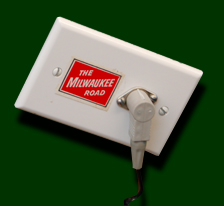

  |
|
Large, multilevel, sceniced layout, designed for operations. Enjoy the mass of 2 rail O scale. Features DCC (some sound) with car card/waybill operations based in the 1950's in the midwest. Steam and diesel. Coal, reefers, oil, milk and bananas form an interesting traffic mix. Report on op session by Mike O'Brien. |
|
We had the pleasure of participating in an all-day operating session on Ted's layout near Chicago during a convention in April 2006. He operates using DCC command control, some ground throw and some power switches, car cards and waybills, and an informal "ask the roving dispatcher (Ted himself)" dispatching system. Normal operation of the layout is with a bigger crew, more throttles and a dispatcher, but because of construction concerns and dust above the basement Ted went with fewer crew members this time. Train order boards at stations are being installed. The layout is multi-level, running from hidden staging at the lowest level to hidden staging at the highest level. There are from one to three visible levels in between. There is no helix--tracks wind around the room gaining elevation, although there is a hidden loop around the stair/restroom that gains elevation. In O scale, which needs large radius curves, it seems to be the best solution to go from level to level by wrapping around the room. The problem of way freight switching on grades is solved here by having "brakes" where needed which consist of a metal wire sticking up between the rails, operated by a knob on the fascia.
|
|
Note that trains are up close to the aisle for great viewing. Some buildings are still cardboard mockups, but to scale and shape. Lots of info is along the fascia. Note lower fascia is grass green, while upper fascia is sky blue. Carpet and under-layout skirting are brown. At the far left of the upper level you can just see a sturdy handle, useful for balance while standing on the step.
|
|
|
|
We like
the clever use of a switch plate for the throttle plug, with a Milwaukee
Road emblem (upper right). |
|
|
|
|
|
|
|
|
|
|
|
BELOW, our
last picture, a verrrrrry wide panorama of the layout room. You may scroll
to the right to see it all. |
 |
Email contact: mike at (@) corbu.us -- Mike O'Brien, Pasadena, CA